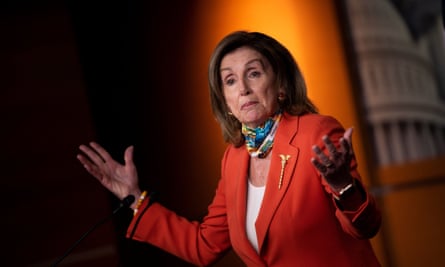House Democrats will unveil an aggressive climate crisis “action plan” on Tuesday to nearly eliminate US emissions by 2050, according to summary documents reviewed by the Guardian.
The net-zero emissions goal is what United Nations leaders and the scientific community say the world must achieve to avoid the worst of rising temperatures, and it’s what the Democratic presidential nominee, Joe Biden, says he would pursue if he were to win the White House in November.
The Democrats’ proposal, referred to in a two-page summary as a “congressional action plan” and a “roadmap”, calls for interim targets to assess progress and make sure fossil fuel pollution is declining, particularly in communities of color that have suffered environmental injustices.
The House speaker, Nancy Pelosi, will announce the plan, compiled by the House select committee on the climate crisis that is chaired by the Florida congresswoman Kathy Castor, at an event in front of the US Capitol on Tuesday morning.
The more than 538-page report will include hundreds of policy recommendations focused on 12 key pillars, according to a separate outline.
Modeling on a subset of those recommendations showed they would cut net US greenhouse gas emissions by 37% below 2010 levels in 2030, and 88% below 2010 levels in 2050, according to the report outline. The remaining 12% of emissions cuts would have to come from hard-to-decarbonize sectors, including heavy-duty truck transportation, industry and agriculture.
The proposal outline recommends a clean energy standard for net-zero electricity by 2040 and net-zero new buildings by 2030. It calls for only zero-emitting new vehicles to be sold by 2035, and it advocates for doubling funding for public transit.
The plan provides a “roadmap for Congress to build a prosperous, clean energy economy that values workers, advances environmental justice, and is prepared to meet the challenges of the climate crisis”, according to the documents.
Leah Stokes, an assistant professor at the University of California, Santa Barbara, who studies climate policy, called the plan “ambitious and comprehensive”.

“It shows that the committee has been listening to stakeholders, and has watched the Democratic primary carefully. Clearly they have learned from climate champions like [Washington] Governor Jay Inslee,” she said.
“I am very heartened to see the detail and ambition that the committee has put forward – it shows that the Democratic party is waking up to the scale and urgency of the climate crisis.”
However, the plan has no chance of passing a Republican-controlled Senate, and would be a difficult sell even for some Democrats if their party took back that chamber and won the White House from Donald Trump. The president has vowed to exit the Paris climate agreement and has rescinded the country’s national climate efforts.
Democrats will tout that the plan would provide almost $8tn in climate and health benefits through the middle of the century, but Republicans are sure to zero in on the proposal’s costs, arguing that they will stifle an already struggling economy.
Investments would also be made to stem and respond to climate impacts, including water infrastructure to handle increased flooding and a next-generation 911 system to make sure wireless communications networks are reliable during disasters.
The plan would aim to reduce methane leaks from the oil and gas sector 90% by 2030, noted Stokes, who reviewed the full report.
Oil and gas companies would no longer get “unnecessary tax breaks” and the US would place a price on carbon to make companies pay for their pollution. Under the plan, Congress would also implement policies to make sure heavy industries cut pollution in vulnerable communities, so that poor Americans and communities of color do not suffer from the transition.
The roadmap would “put [environmental justice] at the center of federal climate and environmental policy.”
It would also establish a national climate adaptation program and protect at least 30% of all US lands and ocean areas by 2030.
A national economic transition office would help displaced workers, and coal industry veterans would get healthcare support.
Finally, the proposal would invest in “climate literacy”.
“Turning this plan into reality will build a safer, healthier, and fairer America, restore our global climate leadership, enhance our national security, and provide a livable climate for today’s youth and future generations,” the documents say.



